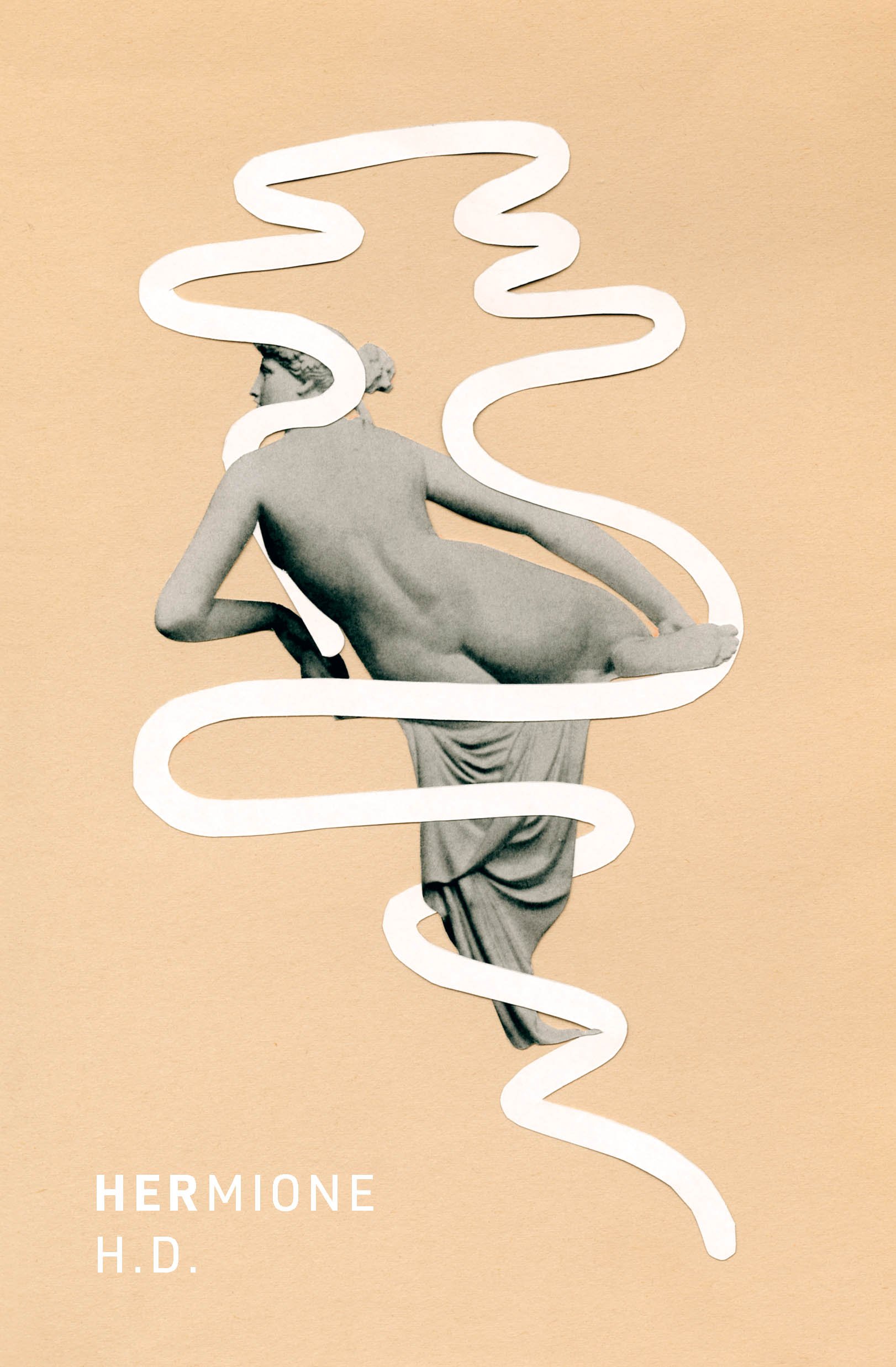
I FIRST READ the poet H.D.’s autobiographical novel HERmione when I was twenty-four. This was 1981; the book had just been rediscovered in the Beinecke Rare Book & Manuscript Library at Yale and published by New Directions, more than a half century after its completion in 1927. Although I was of a different generation entirely, my life at the time resembled that of Hermione Gart, the novel’s heroine: graduated from college, struggling to craft a poetic voice amid the disorienting forces of a patriarchal family and a male-dominated literary world. It was a coming-of-age story I read with shock and relief.
HERmione’s cubist forays into syntax and its woven repetitions capture the alienating loneliness of the author’s childhood home in Pennsylvania. The heroine-narrator unnervingly refers to herself as “Her”—the object of others’ perceptions, even when we would expect her to be the subject of her own actions: “Her saw trees fly past her, trees darting downward, herself static. Trees showed clear in outline, but darker, all one colour, colour of dark cedars.” I had never read anything like it. The novel’s impressionistic urgency embodies the awakening rhythms of poetic perception. At the same time, its stream-of-consciousness and other experimental techniques are shot through with humor and sardonic honesty, lending an American directness to a high-Modernist text that engages candidly with racism, sexism, classism, and bourgeois hypocrisy.
Now, over forty years after my first read, New Directions has given us a beautiful reissue of this still-startling novel, with an illuminating afterword by Francesca Wade. If you are familiar with twentieth-century American poetry, you have probably heard how Ezra Pound launched Hilda Doolittle’s literary career out of obscurity in 1912 by declaring, “But Dryad, this is poetry!” and scrawling a new name and literary affiliation—“H.D. Imagiste”—at the bottom of a manuscript of her poems. As Wade remarks, H.D. is still largely defined in literary lore by her relationships with the men around her. But HERmione offers H.D.’s own version of the founding era of modernism, a necessary and illuminating corrective. Ezra Pound appears here as George Lowndes, just back from Italy, affected and dandified in billowing scarves. Judging and posturing and mansplaining, he quotes Longfellow and Swinburne to Hermione ad nauseam, tells her she looks “like a Greek goddess or a coal scuttle,” criticizes everything from her hat to the play she wants to see (“It’s so unlike you, Hermione, not to have more discrimination”), and tells her that her poetry is “rot.” When George pins her down to kiss her on a mossy forest floor, she feels that she is going to be “smudged out.”
It is the sensibility of the mature H.D., a productive writer living in Europe (“in an ornate chateau on the shores of Lake Geneva,” as the afterword tells us) with her female partner, Bryher, and her daughter, that steps in somehow to liberate her trapped younger self. Perhaps because H.D. wrote about this traumatic, crucial year of her young adulthood multiple times in different books, HERmione succeeds in transposing the sophisticated, awakened sensibility of the elder writer onto the experience of the recent college graduate struggling to breathe within the constraints of a mundane, bourgeois, patriarchal world. The result is a kind of time travel, a glorious clashing of present against past, both painful and liberating, as every oppressive expectation young Hermione must meet is rendered palpable by relentless detail: “. . . table and cloth and careful lines of the oblong pattern where the folded cloth had been carefully unfolded, making two careful lines, bisecting teacups cluttered and teacup scattered . . .”.
The young poet experiences language as raw, perpetually unfamiliar.
Thanks to this double consciousness of past and present, we understand why Hermione, outmatched by her banal surroundings and lacking support for her burgeoning gifts, is planning to marry George at the beginning of the book—and why she changes her mind by the end. In between, she finds affirmation through a relationship with the free-spirited Fayne Rabb (a character based on a real-life woman H.D. loved, Frances Gregg). In the welcoming atmosphere of Fayne’s attention, it is clear Hermione has been suffering torments of self-consciousness and loneliness. Swinburne’s lush, eerie poem “Itylus,” which the two recite constantly as they fall in love, suggests a background of sexual abuse. In the myth behind the poem, Philomela is sexually molested by her sister Procne’s husband, who cuts out her tongue to ensure her silence. Philomela weaves the tale into a tapestry and shows it to her sister, who kills her eldest son Itylus in revenge and serves him to his father as a meal. The sisters escape together and ultimately transform into birds. The poem’s echoing refrain, “Swallow, my sister, O sister swallow,” spreads through this part of the book, expressing how the bird sisters struggle to deal with their trauma, one through denial and one through constant repetition.
Like Philomela, the nightingale with her tongue cut out, Her feels her voice to be stifled as both a woman and a poet. In her childhood home, she is afraid her body is revealed too much under a thin summer dress. She feels herself paralyzed by being touched or looked at, as if turned to stone. She is cut off from other women and from female strength, alienated from her mother and sister-in-law by a family structure that divides them even as it traps them together. And she is separated by a white supremacist culture from a full connection with one of the strongest female characters in the book—Mandy, the cook.
One thing is clear: Her is a writer, and words are all that can save her. “Words were her plague and words were her redemption.” The young poet experiences language as raw, perpetually unfamiliar: “She ran words along like a child reading out of a first primer.” When George Lowndes asks her, “What do you read?” she answers, “I don’t know, George. I am the word AUM,” prompting him to tell her not to talk anymore. While George silences Hermione’s voice, Fayne Rabb brings it from her, almost by force:
The words were (as it were) dragged out of her throat by a small hand, by a tight hand, by a hard dynamic forceful vibrant hand. The hand of Fayne Rabb dragged words out of the throat of Her Gart. . . Words with Fayne in a room, any room, became projections of things beyond one. . . So prophetess faced prophetess.”
Wade, in her afterword, suggests that “HERmione is perhaps the most radical of all [H.D.]’s novels in its triumphant refusal of what the poet Adrienne Rich calls ‘compulsory heterosexuality,’” and guesses that may be the reason it remained so long unpublished. This welcome new edition underscores the importance of the novel’s initial rediscovery and signals that it’s time for HERmione to solidify its reputation as an important lesbian novel and feminist literary touchstone—and to be duly acknowledged as many other things as well: a crucial corrective for some of the founding myths of modernist poetry, an American female bildungsroman, and a central work by a distinctive voice in experimental modernist fiction.
I wish I could time travel, too, and bring my own current awareness back to the scattered young self who first read this book. I wonder what I would tell her. Perhaps something that H.D., mistress of spiraling syntax, would have wanted to hear: that this is a novel that bears rereading, that changes on rereading, that changes as we change, that reminds us that change is life.

